Popular science and venture capital at the Global Technology Symposium conference in San Francisco
Managing Director of the DFT Aurora venture fund Alexander Johnson probably loves to cook. The other day, she, as a real chef, prepared an exotic conference dish called “Global Technology Symposium” . His recipe is:
What happened:
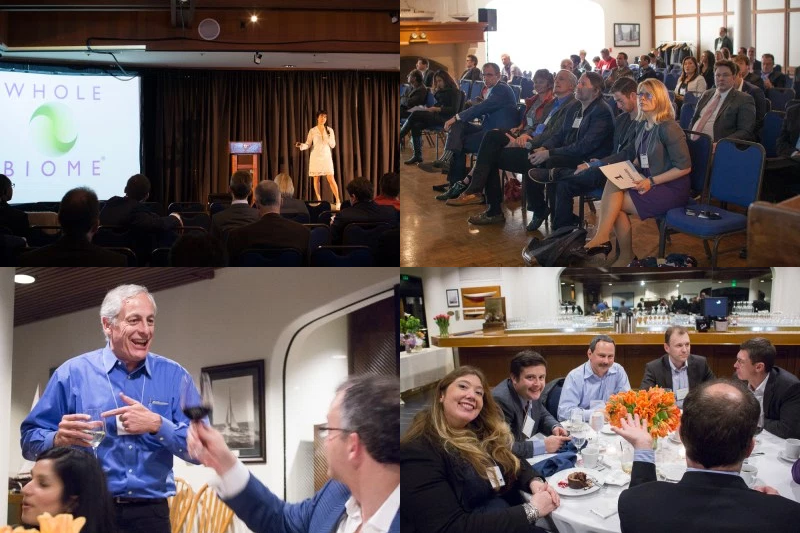
Yacht Club (interesting, only I had an association with the cartoon "The Adventures of Captain Vrungel"?):

')
We go to the buffet table:
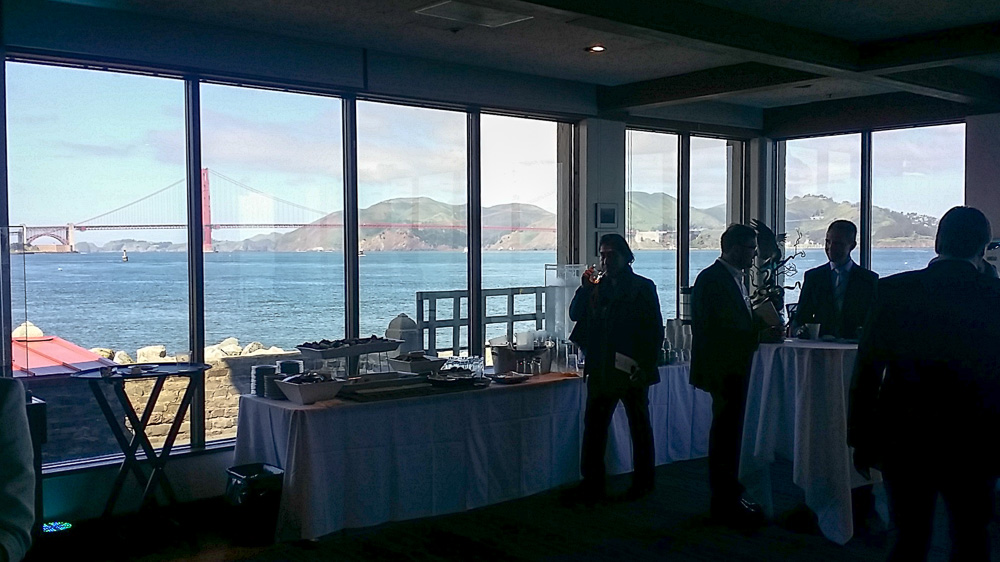
Here comes Alexandra Johnson in person:

Behind her relative Franklin Pitcher Johnson jr. , famous venture capitalist:

We go in the hall of presentations. You will not believe, but this girl Colleen Cutcliffe, somewhat similar to the good girl Lida from the movie about Shurik's adventures, or rather her Asian version, works not only as a research biologist, but as president of a whole startup Whole Biome funded by venture capitalists. Lida would not be able to do this, since she lived under socialism, and after the polytechnic, she would work with Shurik in the scientific research institute:

Colleen said that it turns out people can be fat or thin, depending on the bacteria that live in them. It was tested on mice, which planted bacteria that are full or, on the contrary, cause weight loss:
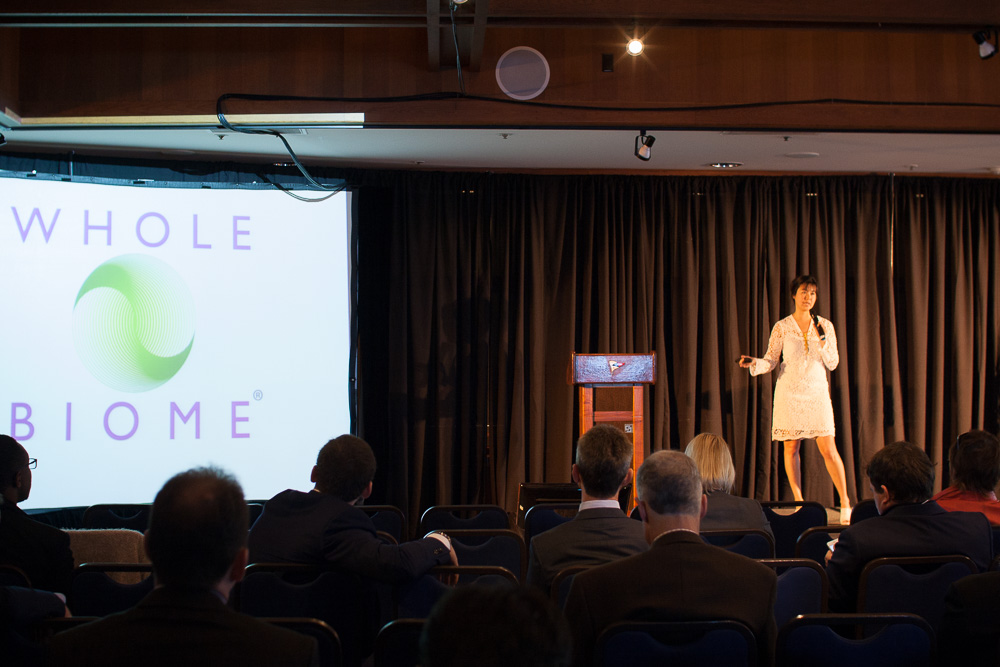
The participants of the symposium listened attentively. Right in a gray tie - a representative of the Russian embassy:
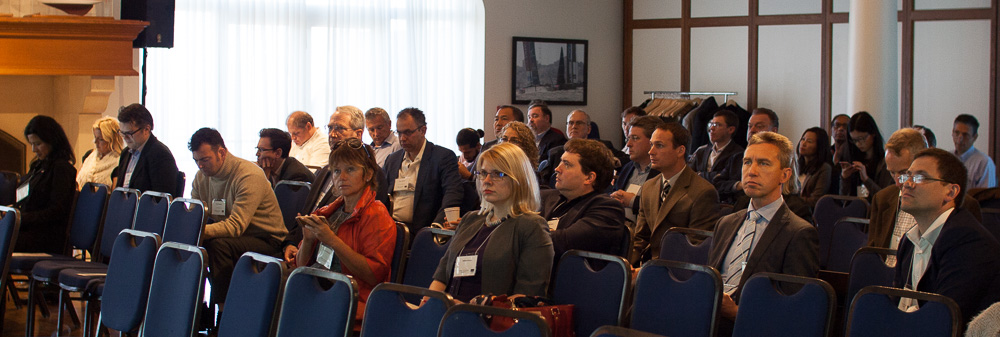
One of the participants of the GTS, a businessman from Russia Denis Pomogayev (Rhonda Software Development Services) asked the biological girl a question as to whether they are going to plant genetically modified bacteria, the functionality of which could be asked using the new language to describe DNA by analogy with the creation of electronic circuits using the Verilog language. The girl said that genetically modified bacteria is nice, but if the transfer of genes to other bacteria begins (the bacteria can do it), the consequences can, hmm, vary:

After several such speeches, the people went to lunch, during which several venture capitalists spoke with different specializations:

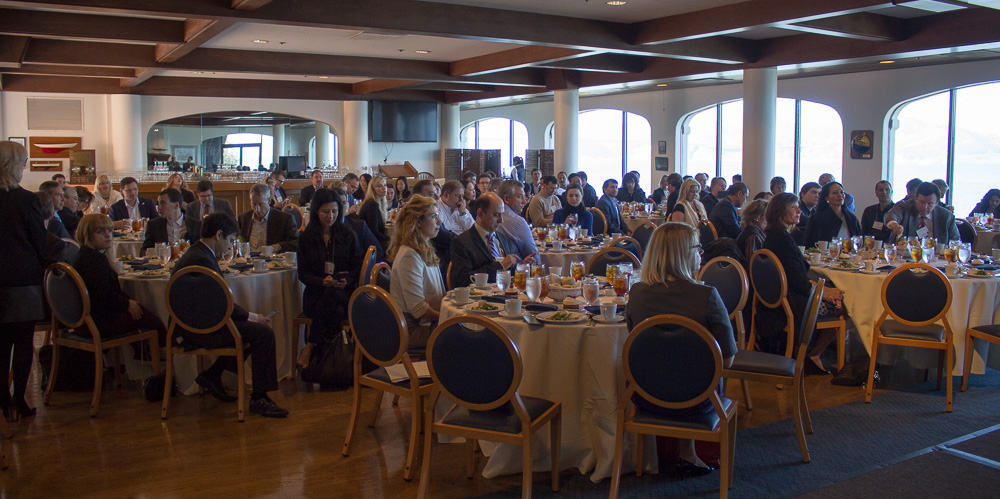
An interesting topic emerged in the discussion: Tim Draper, a well-known VC (pictured with a red tie), said that for a typical public company (that is, a company whose shares are traded on the stock exchange), maintaining its status costs about $ 5 million dollars in legal proceedings . At the same time, classic start-ups are not traded on the stock exchange - according to the laws “on the protection of widows and orphans” (inexperienced investors from unscrupulous fundraisers) there are a large number of restrictions on operations with shares of young private companies. According to Tim Draper, there is now a trend against the rigid division of companies into public and private - venture capitalists, investment bankers and government regulators are discussing alternative, more flexible mechanisms for transferring money from a business project to a business project.
The time has come for questions and answers. I got up and said: “Many of those present in the hall remember the end of the 1990s, the dot-com bubble and the associated overlaps and overkill, including the abundance of inexperienced start-up founders, ridiculous business plans and the general unprofessionalism that swept the Valley. Do you think that the founders of startups and management teams have learned anything since ”?
Tim Draper answered me: “What you describe has a somewhat cyclical nature. At the beginning of each cycle, the founders of startups are inexperienced young people, then, when they do a lot of things, investors say “no, let us have professional teams”. In our venture fund, we prefer to work with young people, as they start with a new technical base, without old baggage ”:

At the end of lunch, I noticed Ilya Ponomarev in the hall of an opposition Russian politician. I talked to him, and Illya said that now he is more busy working in Ukraine than in Russia:
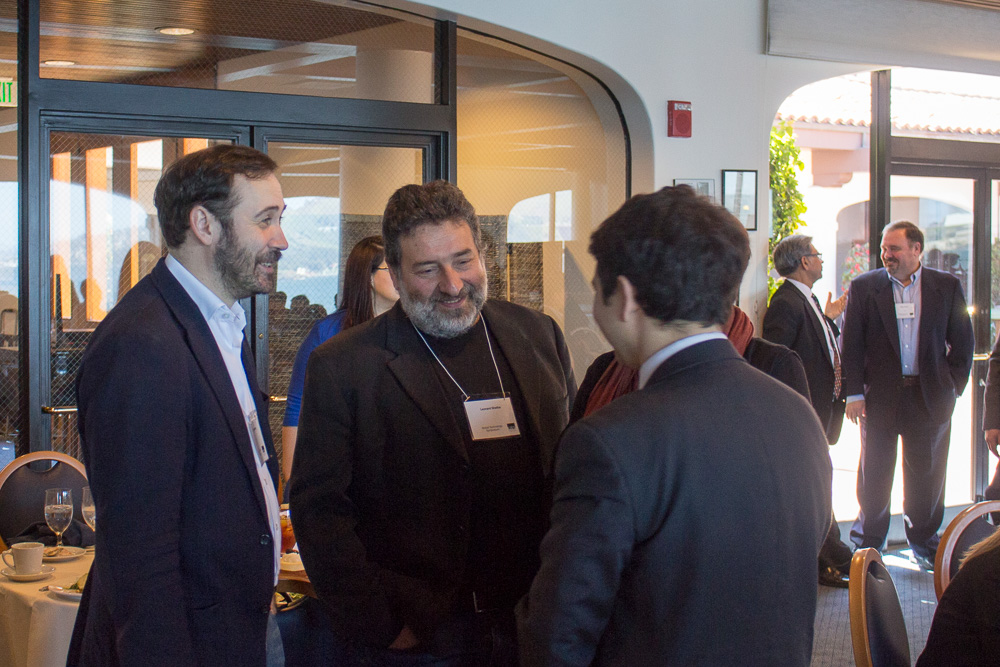
After lunch, the Syrian girl Puneh Ala'i from Los Angeles spoke, who recently traveled to Syria, helping children destitute of war:

After the girl, the well-known marketer Patrick Renvoise , author of the book “Neuromarketing”, spoke. Patrick said that scientists believe that the human brain is the layering of the “logical” mammalian brain over the older “reptilian” brain, which is not based on reasoning, but on “well, it seems to me that I want it and that’s it.” Patrick proposes to focus marketing exclusively on the reptilian brain and his Paleozoic desires, without wasting time trying to logically prove anything. And the logic of spending on homework, trying to determine what the client's reptilian brain wants.
In particular, according to Patrick, Starbucks’s success is due to the fact that people are tired of traveling between work and home all the time and they found in Starbucks a “third place” where they can hang between demanding households and a demanding boss at work. And not just to hang out, but in comfort, drinking coffee with Wi-Fi.
I caught Patrick on inaccuracies. Patrick began to tell how Netscape in the early 1990s found it difficult to sell investors the idea of a browser without a demo. To which I said that the demo was already there and it was called Mosaic. Patrick said, “Well, so Netscape is Mosaic,” I paired “Mosaic as a program appeared before Netscape as a business,” after which Patrick said, “well, it was used only in universities, so it was rather difficult for the founders to prove to investors that it would and to the general public. "
After Patrick’s lecture, I, to smooth out the roughness, said that we were colleagues to some extent - he worked at Silicon Graphics, and the team in which I work at Imagination Technologies (MIPS Business Unit) is the former MIPS Technologies team, before that Branches of Silicon Graphics. One of my bosses was right on that team at Silicon Graphics. Patrick said, “Oh, you are a MIPS man,” after which I handed him an article about MIPS in Russia in the form of a microprocessor, Baikal-T .

After that, a start-up competition began, which was evaluated by the jury with a representative of Silicon Valley Bank and other well-known comrades:

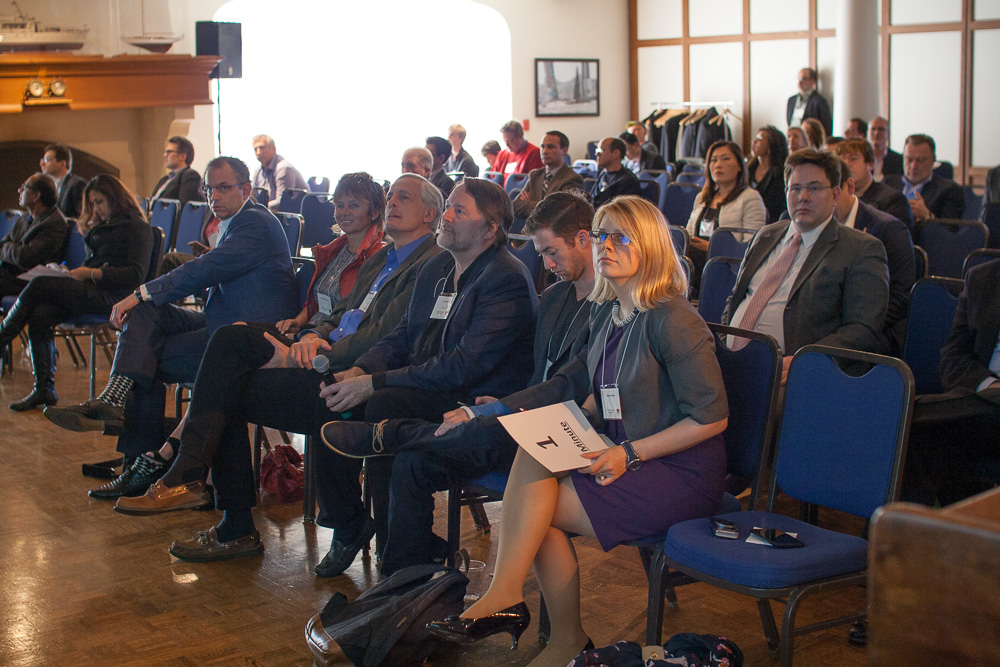
Most of all the excitement caused a startup from Russia with a project of wireless charging in the far distance - http://globalenergytransmission.com . I noticed that the founder of the startup studied at MIPT, and we talked about the hostels in Dolgoprudny:
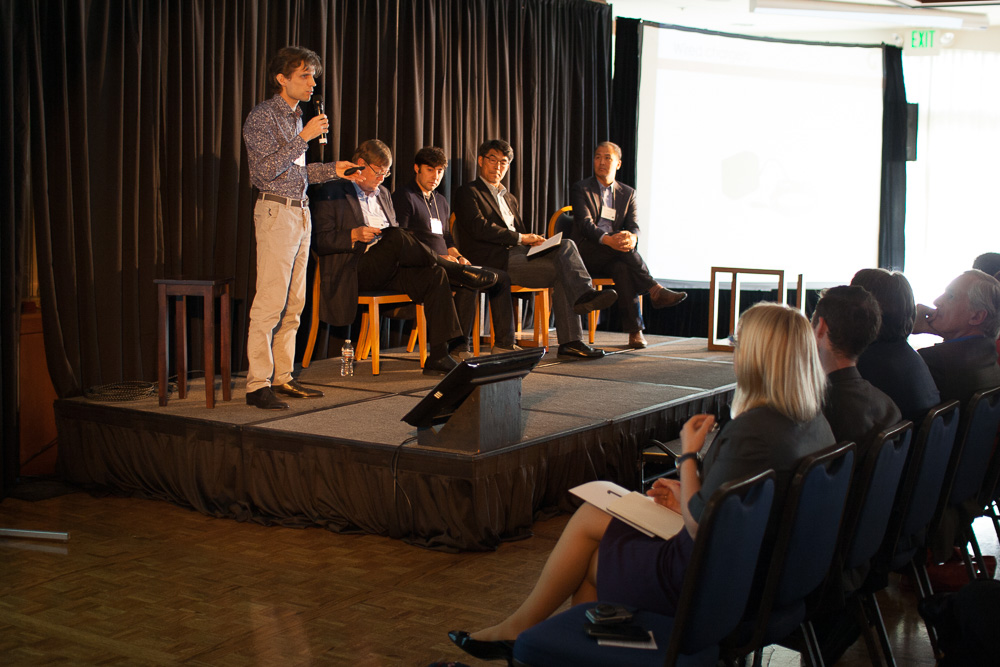
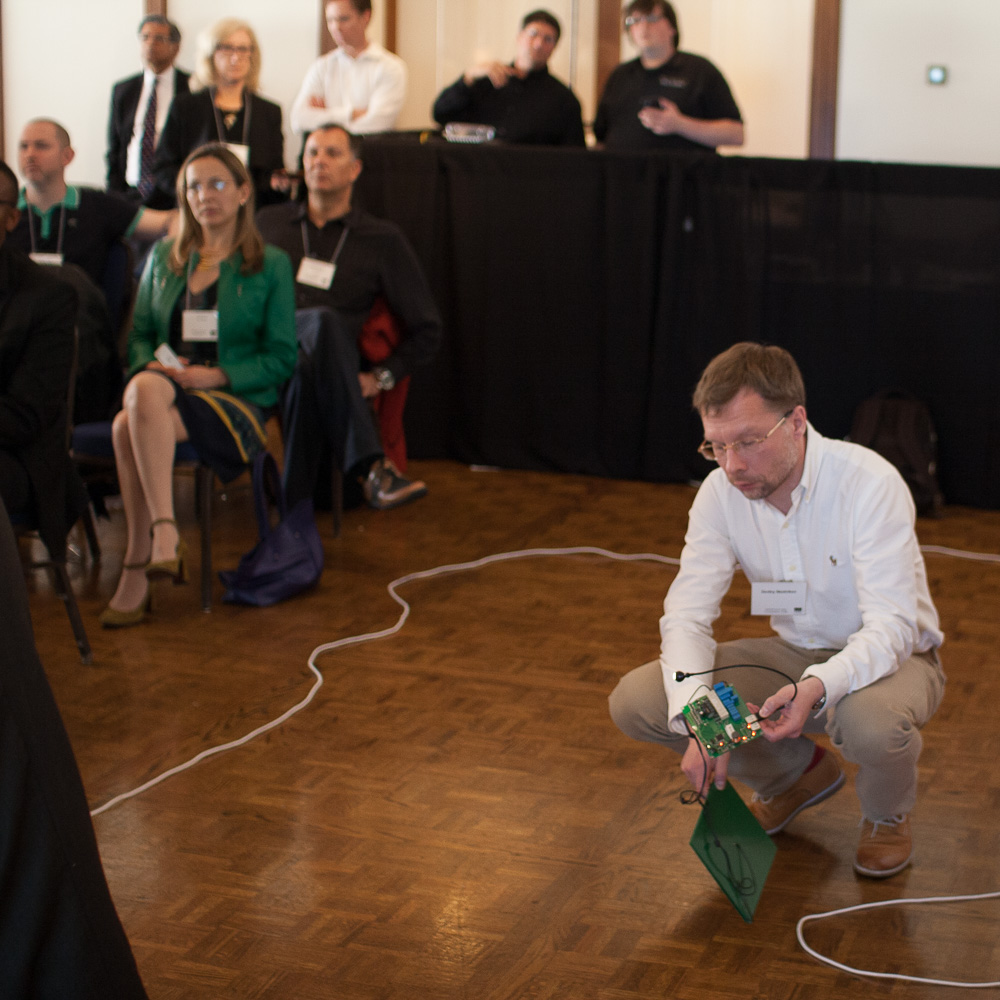
Then there was a break. The photo shows a well-known investor in pharmaceutical startups Evgeny Zaitsev and President of the American branch of RUSNANO Dmitry Akhanov :

The evening began to toast. First, the toasts were for San Francisco, then for New York, then for France, then for Norway, then for Ukraine, and finally Alexandra said “now let's talk about a country that nobody has yet called” and made a dramatically embarrassed pause - “ Russia! "
Toasts for Russia volunteered to pronounce four, including me. I began to spread across the tree and tell me that I met Alexandra Johnson through a joint Russian-American project of my late friend and teacher Oleg Batsukov from MIPT, whom I helped to find in 1996 with the first contract with Mentor Graphics to develop a microprocessor model Hitachi SH-1.
“In short!” Demanded Alexander. “Here are three more speakers. Where is the toast? ”
To which I said: “Whatever happens to politics, businessmen will find a way to conduct joint projects of Russia with America, Europe and Asia!”
The people clapped, after which the last speaker commented that 12 years ago GTS (Global Technology Symposium) started at Stanford as RTS (Russian Technology Symposium) and everyone started the last discussions.



Again on GTS, Denis Pomogaev and Andrey Mishchenko from Rhonda Software Development Services - a company from Vladivostok, which developed embedded software and some image processing hardware and helped develop more than 200 (!) Cameras, including cameras from Nikon, Panasonic, Fujifilm, Sony, Samsung , Pentax, Olympus, etc.

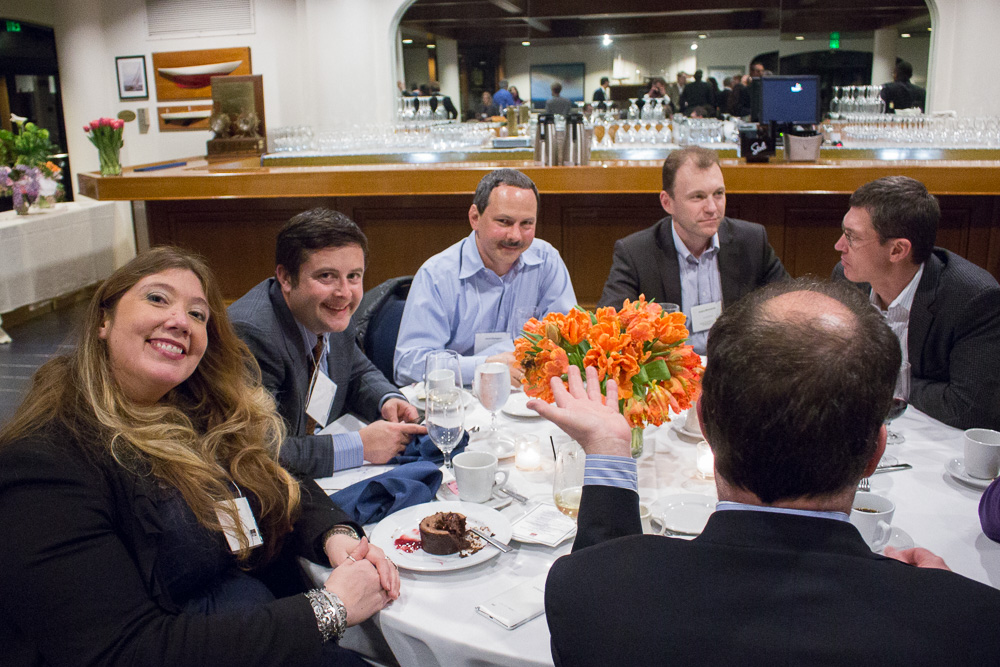
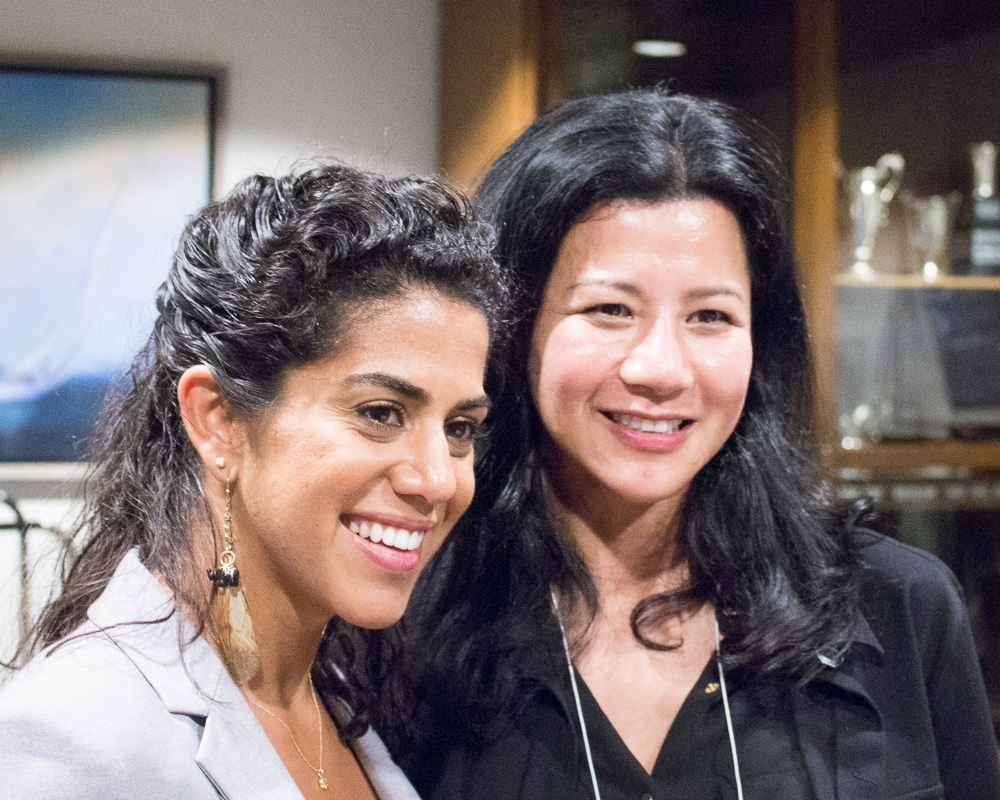

Verdict. The tasting of the dish called “Global Technology Symposium” was more than positive. Despite the fact that I often go to other conferences , I clearly see at least several categories of people who can get pleasure from the GTS:
- Take a couple of American venture capitalists from the old Silicon Valley guard
- Add a middle-aged VC, VC-women and a couple of young men from new-fashioned seed funds and accelerators
- We invite a representative of Silicon Valley Bank, known to work with VC. As well as a representative of Wilson Sonsini Goodrich & Rosati, the largest law firm of Silicon Valley
- Here are a couple of Russian consuls, trade representatives of Russia and Tatarstan, and the president of RUSNANO’s US division
- Let's introduce for the balance of the Russian opposition parliamentarian Ilya Ponomarev, who had dinner with the oppositionist Yashin before the conference
- We will hire several scientists, inventors and marketing gurus for lectures / presentations, which are really interesting to listen to without fools.
- We will bring several physicians from the 2nd Dolgoprudny hostel, with their shocking invention of transmitting electricity over (relatively) long distances without wires
- Put in the middle of the program an attractive Syrian girl from Los Angeles, with a story about a charity trip to Syria, in which her father was afraid to let her go with her mother
- Add other international shades - promoter of the startup ecosystem of Hong Kong, investors from France and Norway, Internet entrepreneur from Nicaragua
- Put all this company in a yacht club in an unreal beautiful piece of San Francisco overlooking the prison island of Alcatraz and Golden Gate Bridge, and set to cook for two days
What happened:

Yacht Club (interesting, only I had an association with the cartoon "The Adventures of Captain Vrungel"?):

')
We go to the buffet table:

Here comes Alexandra Johnson in person:

Behind her relative Franklin Pitcher Johnson jr. , famous venture capitalist:

We go in the hall of presentations. You will not believe, but this girl Colleen Cutcliffe, somewhat similar to the good girl Lida from the movie about Shurik's adventures, or rather her Asian version, works not only as a research biologist, but as president of a whole startup Whole Biome funded by venture capitalists. Lida would not be able to do this, since she lived under socialism, and after the polytechnic, she would work with Shurik in the scientific research institute:

Colleen said that it turns out people can be fat or thin, depending on the bacteria that live in them. It was tested on mice, which planted bacteria that are full or, on the contrary, cause weight loss:

The participants of the symposium listened attentively. Right in a gray tie - a representative of the Russian embassy:

One of the participants of the GTS, a businessman from Russia Denis Pomogayev (Rhonda Software Development Services) asked the biological girl a question as to whether they are going to plant genetically modified bacteria, the functionality of which could be asked using the new language to describe DNA by analogy with the creation of electronic circuits using the Verilog language. The girl said that genetically modified bacteria is nice, but if the transfer of genes to other bacteria begins (the bacteria can do it), the consequences can, hmm, vary:

After several such speeches, the people went to lunch, during which several venture capitalists spoke with different specializations:


An interesting topic emerged in the discussion: Tim Draper, a well-known VC (pictured with a red tie), said that for a typical public company (that is, a company whose shares are traded on the stock exchange), maintaining its status costs about $ 5 million dollars in legal proceedings . At the same time, classic start-ups are not traded on the stock exchange - according to the laws “on the protection of widows and orphans” (inexperienced investors from unscrupulous fundraisers) there are a large number of restrictions on operations with shares of young private companies. According to Tim Draper, there is now a trend against the rigid division of companies into public and private - venture capitalists, investment bankers and government regulators are discussing alternative, more flexible mechanisms for transferring money from a business project to a business project.
The time has come for questions and answers. I got up and said: “Many of those present in the hall remember the end of the 1990s, the dot-com bubble and the associated overlaps and overkill, including the abundance of inexperienced start-up founders, ridiculous business plans and the general unprofessionalism that swept the Valley. Do you think that the founders of startups and management teams have learned anything since ”?
Tim Draper answered me: “What you describe has a somewhat cyclical nature. At the beginning of each cycle, the founders of startups are inexperienced young people, then, when they do a lot of things, investors say “no, let us have professional teams”. In our venture fund, we prefer to work with young people, as they start with a new technical base, without old baggage ”:

At the end of lunch, I noticed Ilya Ponomarev in the hall of an opposition Russian politician. I talked to him, and Illya said that now he is more busy working in Ukraine than in Russia:

After lunch, the Syrian girl Puneh Ala'i from Los Angeles spoke, who recently traveled to Syria, helping children destitute of war:

After the girl, the well-known marketer Patrick Renvoise , author of the book “Neuromarketing”, spoke. Patrick said that scientists believe that the human brain is the layering of the “logical” mammalian brain over the older “reptilian” brain, which is not based on reasoning, but on “well, it seems to me that I want it and that’s it.” Patrick proposes to focus marketing exclusively on the reptilian brain and his Paleozoic desires, without wasting time trying to logically prove anything. And the logic of spending on homework, trying to determine what the client's reptilian brain wants.
In particular, according to Patrick, Starbucks’s success is due to the fact that people are tired of traveling between work and home all the time and they found in Starbucks a “third place” where they can hang between demanding households and a demanding boss at work. And not just to hang out, but in comfort, drinking coffee with Wi-Fi.
I caught Patrick on inaccuracies. Patrick began to tell how Netscape in the early 1990s found it difficult to sell investors the idea of a browser without a demo. To which I said that the demo was already there and it was called Mosaic. Patrick said, “Well, so Netscape is Mosaic,” I paired “Mosaic as a program appeared before Netscape as a business,” after which Patrick said, “well, it was used only in universities, so it was rather difficult for the founders to prove to investors that it would and to the general public. "
After Patrick’s lecture, I, to smooth out the roughness, said that we were colleagues to some extent - he worked at Silicon Graphics, and the team in which I work at Imagination Technologies (MIPS Business Unit) is the former MIPS Technologies team, before that Branches of Silicon Graphics. One of my bosses was right on that team at Silicon Graphics. Patrick said, “Oh, you are a MIPS man,” after which I handed him an article about MIPS in Russia in the form of a microprocessor, Baikal-T .

After that, a start-up competition began, which was evaluated by the jury with a representative of Silicon Valley Bank and other well-known comrades:


Most of all the excitement caused a startup from Russia with a project of wireless charging in the far distance - http://globalenergytransmission.com . I noticed that the founder of the startup studied at MIPT, and we talked about the hostels in Dolgoprudny:


Then there was a break. The photo shows a well-known investor in pharmaceutical startups Evgeny Zaitsev and President of the American branch of RUSNANO Dmitry Akhanov :

The evening began to toast. First, the toasts were for San Francisco, then for New York, then for France, then for Norway, then for Ukraine, and finally Alexandra said “now let's talk about a country that nobody has yet called” and made a dramatically embarrassed pause - “ Russia! "
Toasts for Russia volunteered to pronounce four, including me. I began to spread across the tree and tell me that I met Alexandra Johnson through a joint Russian-American project of my late friend and teacher Oleg Batsukov from MIPT, whom I helped to find in 1996 with the first contract with Mentor Graphics to develop a microprocessor model Hitachi SH-1.
“In short!” Demanded Alexander. “Here are three more speakers. Where is the toast? ”
To which I said: “Whatever happens to politics, businessmen will find a way to conduct joint projects of Russia with America, Europe and Asia!”
The people clapped, after which the last speaker commented that 12 years ago GTS (Global Technology Symposium) started at Stanford as RTS (Russian Technology Symposium) and everyone started the last discussions.



Again on GTS, Denis Pomogaev and Andrey Mishchenko from Rhonda Software Development Services - a company from Vladivostok, which developed embedded software and some image processing hardware and helped develop more than 200 (!) Cameras, including cameras from Nikon, Panasonic, Fujifilm, Sony, Samsung , Pentax, Olympus, etc.




Verdict. The tasting of the dish called “Global Technology Symposium” was more than positive. Despite the fact that I often go to other conferences , I clearly see at least several categories of people who can get pleasure from the GTS:
- Those who are interested in how venture capitalists work: the future founders of startups, future partners of venture funds, employees of large companies who make decisions about buying start-ups, sociologists and journalists who study start-up culture. In order for the GTS communication to be as effective as possible, it is desirable for such participants to already know the theory of how valuation is done, how business plans are written, classes of actions, financing rounds, types of investors, exit strategies, etc. GTS is a great place to tie this theory to practice, for example, to listen to and compare the approaches of venture funds investing at different stages, from kickstarter and seed funds, to classic funds like DFT, regional funds, corporate funds like Microsoft Seed Fund, and investors like RUSNANO, who invest in already well-developed businesses.
- Another group that might like the GTS are wealthy people with an interest in science and invention, who decided to take a vacation in San Francisco and get something more from him than visiting standard tourist attractions. Although participation in the GTS costs $ 995 (if you buy in advance), but at the conference there is enough high-quality content (invited scientists and inventors) so that representatives of the upper part of the middle class feel that vacation money is well spent. Like how to go to the Smithsonian on steroids, with a touch to the people from whom it all comes. I don’t even speak about the representatives of the rich class - for them it’s a penny, and with the support of socially useful initiatives.
- The third group, for which the GTS gift is government workers, for whom it is useful for the outlook to meet with disparate representatives of business, technology and capital. The conference, which Alexander prepared, is rather unspecialized and at the same time represents many different groups. The natural beneficiaries of the GTS are the representatives of the Russian state, with whom Alexander has long been familiar and who can thus unobtrusively integrate with the global ecosystem of technologies.
Source: https://habr.com/ru/post/392581/
All Articles